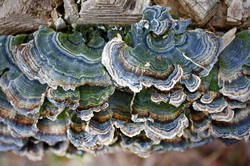Aerobic Yield
- With no information on F/M ratio or influent makeup, I use 0.5 g cells/g BOD5 in the influent.
- With starch and other readily degradable influents, you can increase this to 0.6 g cells/g BOD5.
- High F/M rations (less biomass, more substrate) - you have a higher cell yield which decreases gradually as the F/M lowers - N.B. it is not a linear relationship between F/M and Y. The lower cell yield is actually do to endogenous respiration (cell death) that occurs in the confines of the treatment system so it does have some advantages & disadvantages (I'll post more on this later).
- In practice you see cell yields anywhere from 0.4 - 0.6 in most cases.
- From an energy generation standpoint, anaerobic respiration results in less "energy" for cell growth than aerobic systems. The result is less cell yield per unit of substrate.
- Normal cell yield (Y) is 0.06 g cells/g substrate - which is approximately 10x less than yields fro aerobic systems. This is why high strength wastewaters are often treated with anaerobic digestion.
Now for a general table of Cell Yield



 RSS Feed
RSS Feed